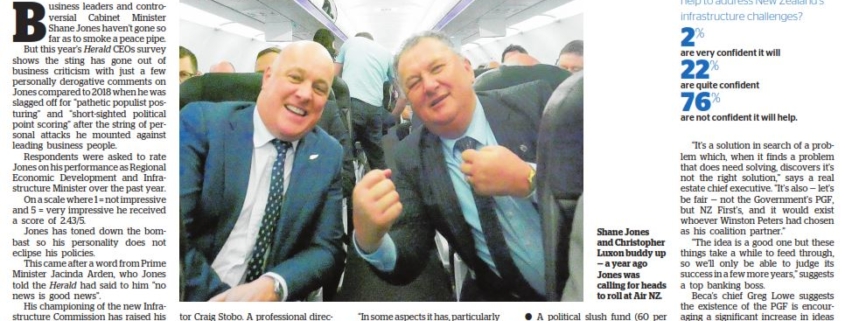http://bit.ly/2mKvhMp
Business leaders and controversial Cabinet Minister Shane Jones haven’t gone so far as to smoke a peace pipe.
But this year’s Herald CEOs survey shows the sting has gone out of business criticism with just a few personally derogative comments on Jones compared to 2018 when he was slagged off for “pathetic populist posturing” and “short-sighted political point scoring” after the string of personal attacks he mounted against leading business people.
Respondents were asked to rate Jones on his performance as Regional Economic Development and Infrastructure Minister over the past year.
On a scale where 1 = not impressive and 5 = very impressive he received a score of 2.43/5.
Jones has toned down the bombast so his personality does not eclipse his policies.
This came after a word from Prime Minister Jacinda Arden, who Jones told the Herald had said to him “no news is good news”.
His championing of the new Infrastructure Commission has raised his reputation with that sector.
But his jawboning has also got results. Air New Zealand, where he called for top brass to go after the airline axed some provincial routes, this year hosted Jones on an inaugural direct flight from Auckland to Invercargill.
Jones, who refers to himself as the “provincial champion”, has attracted criticism over the Provincial Growth fund which sits within his portfoilo responsibilities.
“It has delivered for Mr Jones and NZ First,” suggests independent director Craig Stobo. A professional director suggests it is a “NZ First get re-elected fund”.
The Provincial Growth Fund has been allocated three billion dollars over three years to invest in regional economic development.
Investments include upgrades to infrastructure, such as the announcement earlier this month that the Auckland to Whangārei rail line will be upgraded to the tune of $94.8 million, getting freight trains back up and running by next September.
Some say it has already delivered on what it set out to do.
“In some aspects it has, particularly in attracting investment into the smaller regions,” says a professional services chief.
“Solely based on the recent allocation to rail infrastructure improvement between the North and Auckland,” adds a top exporter.”
Business leaders were asked to choose as many of the following that apply in terms of the Provincial Growth Fund (PGF). They say the fund is:
- In need of financial monitoring to ensure appropriate investments (61 per cent)
- A political slush fund (60 per cent)
- Getting much needed economic focus on regional New Zealand (24 per cent)
- Delivering infrastructure investment that will boost regional links and infrastructure (11 per cent)
When asked how confident they were that the fund would help to address New Zealand’s infrastructure challenges, 2 per cent are very confident and 22 per cent are quite confident. The overwhelming majority — 76 per cent — say they are not confident it will help.
“It’s a solution in search of a problem which, when it finds a problem that does need solving, discovers it’s not the right solution,” says a real estate chief executive. “It’s also — let’s be fair — not the Government’s PGF, but NZ First’s, and it would exist whoever Winston Peters had chosen as his coalition partner.”
“The idea is a good one but these things take a while to feed through, so we’ll only be able to judge its success in a few more years,” suggests a top banking boss.
Beca’s chief Greg Lowe suggests the existence of the PGF is encouraging a significant increase in ideas to improve regional growth. But he says “a more integrated regional plan, bringing a collection of initiatives together within a region that can support each other, might give more effective outcomes”.
Questions about the way in which the PGF operates were frequently raised by respondents. “Investing in the provinces is a great idea — this model for doing so is a joke … ,” says one investment boss. “It has potential in places, but is also open to be used to finance projects that never stacked up in the past,” says another.




Leave a Reply
Want to join the discussion?Feel free to contribute!